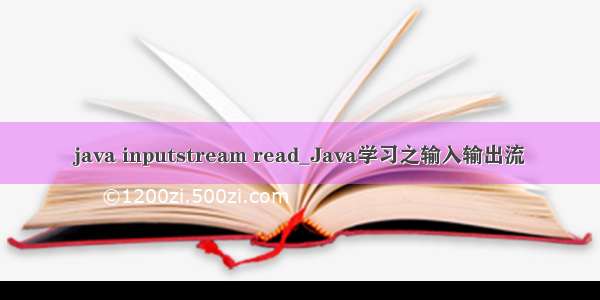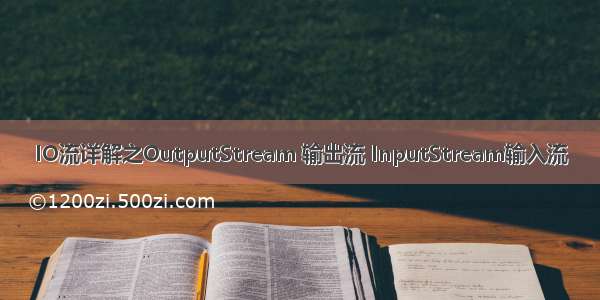
“持志如心痛,一心在痛上,岂有功夫说闲话,管闲事 --摘自阳明先生语录”
Java中通过流来完成输入/输出,所有的输入/输出以流的形式处理,流可以理解为一个数据的序列。输入流表示从一个源读取数据,输出流表示向一个目标写数据。
Java 为 I/O 提供了强大的而灵活的支持,使其更广泛地应用到文件传输和网络编程中,操作I/O的类都被放在http://java.io包中。
根据流中的数据单位分为字节流和字符流。
字节流:流中的数据是以8位字节为单位进行读写,以InputStream和OutputStream为基础类。
字符流:流中的数据是以16为字符为单位进行读写,以Reader和Writer为基础类。
先看看字节流,InputStream和OutputStream是字节流的两个顶层父类,提供了输入流类和输出流类的通用API,这是我在网上找的关于字节流的层次结构图:
InputStream抽象类
InputStream 为字节输入流,本身为一个抽象类,是所有字节输入流的父类,以字节为单位从数据源中读取数据,遇到错误时都会引发 IOException 异常,常用的子类有:
FileInputStream把一个文件作为InputStream,实现对文件的读取操作
ByteArrayInputStream:把内存中的一个缓冲区作为InputStream使用
StringBufferInputStream:把一个String对象作为InputStream
PipedInputStream:实现了pipe的概念,主要在线程中使用
SequenceInputStream:把多个InputStream合并为一个InputStream
如果需要从一个文件读取数据,可以这样:
public static void main(String[] args) {try {InputStream in = new FileInputStream("E:test.txt");int n=0; StringBuffer sBuffer=new StringBuffer();//当n不等于-1,则代表未到末尾while (n!=-1){try {n=in.read();//读取文件的一个字节(8个二进制位),并将其由二进制转成十进制的整数返回} catch (IOException e) {e.printStackTrace();}char by=(char) n; //转成字符sBuffer.append(by);}System.out.println(sBuffer.toString());} catch (FileNotFoundException e) {e.printStackTrace();}}
使用FileInputStream读取文件时,若File类对象的所代表的文件不存在或者其他原因不能打开的话,则会抛出FileNotFoundException,下面为InputStream部分方法:
(1)读取一个byte的数据,返回值是高位补0的int类型值。若返回值=-1说明没有读取到任何字节读取工作结束: int read()
(2)读取b.length个字节的数据放到b数组中。返回值是读取的字节数。该方法实际上是调用下一个方法实现的 : read(byte b[ ])
(3)从输入流中最多读取len个字节的数据,存放到偏移量为off的b数组中:read(byte b[ ], int off, int len)
(4)在使用完后必须对打开的流进行关闭:void close()
(5) 返回输入流中还有多少可读字节 int available()
(6)跳过指定字节 long skip(long n)
OutputStream抽象类
OutputStream为字节输出流,本身为一个抽象类,是所有字节输出流的父类,它以字节为单位将数据写入数据源,遇到错误时都会引发 IOException 异常,常用的子类有:
FileOutputStream:实现对文件的写取操作
BufferedOutputStream:缓冲输出流
PrintStream:打印输出流
还有其他的子类不一一列举了,如果要将数据写入到文件中,可以这样:
public static void main(String[] args) {try {OutputStream out = new FileOutputStream("E:test.txt");out.write( new String("This is test.txt").getBytes() );} catch (FileNotFoundException e) {e.printStackTrace();}catch (IOException e) {e.printStackTrace();}}
这段代码执行后当文件不存在时,会自动创建一个文件,然后将内容写入文件中,如果文件润在将会覆盖文件的原内容。
注意:一定要在最后关闭流,如:
public static void main(String[] args) {OutputStream out = null;try {out = new FileOutputStream("E:test.txt");out.write( new String("This is test.txt").getBytes() );} catch (FileNotFoundException e) {e.printStackTrace();}catch (IOException e) {e.printStackTrace();}finally{if(null != out){try {out.close();} catch (IOException e) {e.printStackTrace();}}}}
将关闭流的操作放在finally块中可以保证不管是否出现异常都能执行关闭流的操作,OutputStream常用方法:
write(int b):一次写一个字节 b- 要写入的字节
write(byte[] b):一次写一个字节数组
write(byte[] b, int off,int len):一次写一部分字节数组
close():关闭此文件输出流并释放与此流有关的所有系统资源。此文件输出流不能再用于写入字节
再看看字符流,Reader和Writer是字符流的两个顶层父类,这是我在网上找的关于字符流的层次结构图:
Reader抽象类:
Reader抽象类是所有字符输入流的超类,它以字符为单位从数据源中读取数据,遇到错误时会引发 IOException 异常,常用的子类:
BufferedReader:字符缓冲输入流
InputStreamReader:字节流到字符流的桥接器
使用BufferedReader读取文件内容:
public static void main(String[] args) {try {Reader reader = new BufferedReader(new FileReader("E:test.txt"));int n=0; StringBuffer sBuffer=new StringBuffer();while (n!=-1){n = reader.read();char by=(char) n;sBuffer.append(by);}System.out.println(sBuffer.toString());} catch (FileNotFoundException e) {e.printStackTrace();}catch (IOException e) {e.printStackTrace();}}
当然你也可以直接使用BufferedReader的readLine来读取内容,该方法每次读取一行内容,如果读到返回null就表示文件结束了。
使用InputStreamReader读取:
public static void main(String[] args) {try {InputStreamReader isr =new InputStreamReader(new FileInputStream("E:test.txt"), "GBK");BufferedReader br = new BufferedReader(isr);StringBuilder strb = new StringBuilder();while (true) {String line = br.readLine();if (line == null) {break;}strb.append(line);}System.out.println(strb);} catch (FileNotFoundException e) {e.printStackTrace();}catch (IOException e) {e.printStackTrace();}}
Writer抽象类:
Writer抽象类是所有字符输出流超类,它以字符为单位从数据写入数据源中,遇到错误时会引发 IOException 异常,常用的子类:
BufferedWriter:字符缓冲输出流
OutputStreamWriter:字符转换输出流
使用BufferedWriter输出:
public static void main(String[] args) throws Exception {//创建一个字符缓冲输出流对象BufferedWriter bw = new BufferedWriter(new FileWriter("E:test.txt")) ;//写数据bw.write("hello");bw.write("world");//刷新流bw.flush();//关闭资源bw.close();}
使用OutputStreamWriter输出:
public static void main(String[] args) throws Exception {//创建一个字符缓冲输出流对象OutputStreamWriter bw = new OutputStreamWriter(new FileOutputStream("E:test.txt")) ;//写数据bw.write("hello");bw.write("world");//刷新流bw.flush();//关闭资源bw.close(); }
如果你觉得不错就分享出去
你也可以关注公众号,随时获取最新文章
PS:预计下月将在公众号做一波活动,可关注公众号回复暗号:“Java” 查看礼品~~














